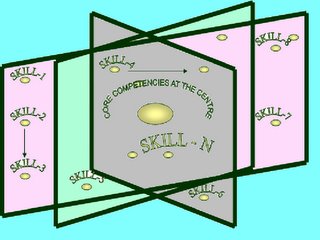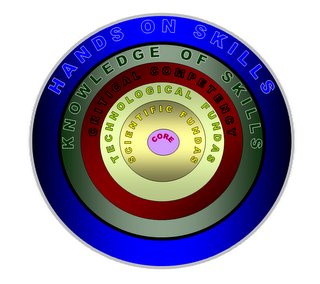PAPER 2
CORE COMPETENCIES
A point for cognizance is that the systems of the next phase may not generally take the overhead of pulling up the students into that phase. Very often, it is the system, in which the student is, that has to push him/her into the next phase, not just by coordinating or managing a relationship but by transmitting to and training the student in those special skills and technologies which are operative in the entry level of next phase with an implied assurance of core competencies. Of course, there are significant number of occasions where this next phase pulls up the students also. (Campus-recruitments, training immediately after employment, etc.)
Whether the above truth of sharing of responsibilities, ratios of responsibilities, who and how much etc. are acceptable to institutes or not is becoming one of the important yardsticks for the institutions, competition among them, the changing perspectives of prospective candidates seeking admissions and their parents.
Hence, the issues that confront an institution are one, building up of core competencies in each student (forget and come out of the narrow-shell of bankrupt and conservative notions of completion of syllabus) and two, to impart worthy skills to the students on the technologies and tools of the contemporary scenario.
[ For this purpose the institute may purchase samples of such. Otherwise, frequent and sharply targeted industrial tours and visits have to be conducted. The world outside our doors is not hostile. It always welcomes pleasantly any initiatives provided we have proper approaches. ]
The core competencies and not the skills of what we made a mention are the essentials of a graduate. They only shape the real growth in his/her future. These core competencies give the intellectual abilities of “non-specific transfer”.
Whereas, the skills are only an edge for an immediate suitability to be a fit into a contemporary scenario – contemporary scenario, to repeat again – of the next phase.
THE RELATIONSHIP OF CORE COMPETENCIES AND CONTEMPORARY SKILLS
Today’s relevant skills may be obsolete tomorrow. Neither there is a need for them to be a continuum of each other. What is to be underlined is that these skills are based upon and constructed upon the core competencies. The core competencies are at the center and the skills are around that center at a random distance and in a random phase.
See below a figure of representation of this relationship.

Fig 4: The Core Competencies and Skills relation scenario
This structure resembles on the whole a sphere if enclosed.
By and large the set of skills are short lived, except a few, when compared to core competencies.
They, instead of forming their own line of relationship often retrace and start from core competencies only.
This is what an institute is supposed to communicate also to the student. The first class of this relationship of skills to core competencies is to be taught at the institution. This combination and this relationship he/she carries for a fully unraveled experience of it in the next phase or in the industry.
Whoever – be it the institute or the industry – may do it, it is to be done.
Though it appears from all this exploration that it is the core competencies crucial in life scale – and truly it is so also, imparting of worthy skills on contemporary technologies and tools is also of equal importance at the student phase according to the same exploration.
This phase is highly sensitive in the whole of life-scale with an excessive reliance on contemporary skills, perhaps due to present day scenario in the job market. Gone or the days for institutions to wash off the hands with mere completion of syllabus. One must be made intelligent and equally smart – note the stress on equally in “equally smart”.
THE CRITICAL COMPETENCY
Another aspect to be noted is that the core competencies would not offer by themselves all that is required to grapple with the contemporary skills. The ability to relate the core competencies with the contemporary skills itself is another core competency. We shall name it as critical competency to give it its unique identity. Without this critical competency an individual can’t develop self dynamism, initiative, etc., in the scenario of fast changes in the requirements of skill-sets. This critical competency of relating the core competencies and the contemporary skills helps a lot for career planning. The one who doesn’t feel that the contemporary skills are estranging the core competencies and who is resolved that what ever be the contemporary skills they are invariably with in the ambit of and can be traced from the core competencies and who with that resoluteness searches and establishes the link can plan well for one’s own career growth. The more vivid is the understanding one has about the relationship the more is, first of all, the assurance and then the pace of upward movement in career-scale.
See in Fig 5 how this critical competency is related with other core strengths and contemporary skills in the intellectual layers.

Fig 5: The hierarchy of intellectual layers
On this critical competency also the institution has to give the basic lessons. With a basic level of combination and a good understanding of relations with this combination a student may be confidently put on the board to embark upon the waters of the next phase. And, then onwards, naturally, it becomes the sole responsibility of the individual to handle the sail, where what the institution can do becomes more or less zero.
At this phase also the relations can be maintained. Alumni is one of the forms which is the dominant, perhaps sole, form. What can be added for the alumni relationship activity is the feedback to have effects on the curriculum, training modes, personality requirements, etc.
The tragedy is that none of the colleges have defined the next product of their institution either as an engineer in general or as a specific engineer in particular. We do not see any declared set of targets – core competencies or skills in their literature and prospectus copies.
What is more disgusting is the attitude of the very university / -ies. They have only a prescribed syllabus to prepare and most of the times or always lagging very much when compared to the contemporary technological conceptual advancements.
What does a student become when goes through the syllabus ? The purpose of the syllabus is not defined. It seems that the syllabus itself is viewed by them as the purpose and not a tool for some other defined purpose. What else can they do ? In this face of a striking deficiency of a defined purpose they have to pull along with the notion that syllabus itself is the purpose.
This is the quantum of bankruptcy of the ‘academicians’ at the apex positions. ‘GOD’ only can save them. But how the students and systems are to be saved ? OF COURSE, THIS IS NOT A MILLION DOLLAR QUESTION. SIMPLE AND CONSCIENTIOUS MINDS AND HEARTS ARE ENOUGH TO LAY THE PATH.
No comments:
Post a Comment